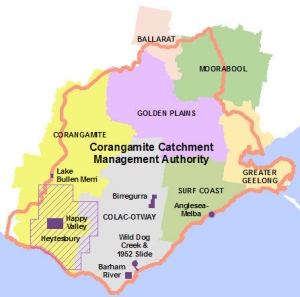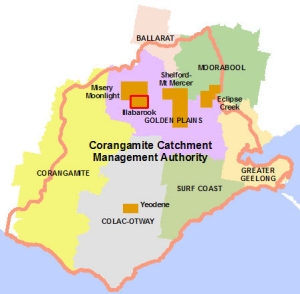Background and Aims
Target Areas and Selection of Sites
Summary of Results
Application for Intended Use
Landslide Trend Maps
Erosion Trend Maps
The knowledge of the distribution and spatial extent of erosion and landslide features throughout the CCAM region is considered a critical element of the current study. However information on the rate of occurrence of these hazards was identified under the 2006/2007 CSHS program as a significant knowledge gap in the understanding of such processes within the CCMA region.
As such, the current trend mapping program aimed to provide information on the rate at which erosion and landslides were appearing or disappearing in the landscape throughout selected sites in the CCMA region.
An early trial of gully and streambank erosion in the Yeodene-Barongarook area was conducted in May 2006 in order to develop a comparative mapping method between two temporal windows. The method involved detailed stereo aerial photograph interpretation (API) of two sets of photos;1946 at 1:16,000 and 2004 at 1:25,000.
The mapping method was extended in November 2006 to include occurrences of both landslides and erosion at various locations in key target areas within the CCMA region. Analysis was then undertaken to determine the temporal changes in the spatial extent of erosion and landslides. As a result, increases or decreases in the rate of occurrence of each hazard type was able to be assessed, providing valuable information on likelihood and possible relationships with land management practices and climatic factors prevalent at the time of the analyses.
Click on area of interest or select from list below:

Barwon River at Birregurra
Happy Valley (Heytesbury Region)
Heytesbury Settlement
Lake Bullen Merri
Melba Parade - Anglesea
Wild Dog Creek (Apollo Bay)
The 1952 Slide Site in the Wild Dog Creek Valley
The choice of target areas within the CCMA region where trend analysis was to be undertaken was based on risk assessment techniques which combined the nature and severity of the impact of a particular hazard with the significance of the asset under threat. A series of target areas were identified through a GIS-based desk-top study and these were further assessed in the field by members of the soil health team during late 2006.
Based on this process, a number of sites were chosen for detailed API analysis with the aim to establishing the temporal rates of occurrence of the specific hazard at each site. A list of the locations and sites chosen for analysis is contained in the following table (the maps appear at right):
Click on area of interest or select from list below:

Illabarook
Misery Moonlight
Shelford-Mt.Mercer Rd
Yeodene (Boundary Creek)